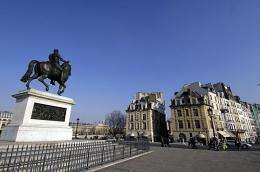Royal head: Scientists identify murdered French king

He was one of France's most adored kings, a monarch known as "le bon roi Henri" (good king Henri), who promoted religious tolerance, was a hit with the ladies and was the first to dream of putting a chicken in every pot.
Alas for Henri IV: on May 14 1610, at the age of 57, his life was cut brutally short by a Catholic fanatic who waylaid him during a procession and slashed him twice in the throat.
Then, during the French Revolution, came a second ignominy.
In 1793, a mob of revolutionaries ransacked the royal chapel at Saint-Denis, north of Paris, hauled the ancient kings from their tombs and mutilated their remains, which were then tossed into a pit.
For the next couple of centuries, a severed head, presumed to be that of Henri IV, led a peripatetic existence, bought and sold at auctions or kept in secretive private collections.
Now, though, a panel of forensic scientists have declared the head is genuine -- and the way is thus open for Henri IV and other desecrated royals to return to the crypt after more than two centuries.
Reporting in the British Medical Journal (BMJ) on Wednesday, the experts harnessed 21st-century detective techniques to probe the exceptionally preserved find.
"The human head had a light brown colour, open mouth, and partially closed eyes," says the study, led by Philippe Charlier, a forensic pathologist at the University Hospital Raymond Poincare in Garches.
"The preservation was excellent, with all soft tissues and internal organs well conserved."
The head had two telltale features that were seen in 16th-century portraits of the king.
One was a dark, mushroom-like lesion, 11mm (0.44 of an inch) long, just above the right nostril. There was also a large hole in the right ear lobe, with a sheen indicating long use, that came from an earring -- again, something frequently seen in Henri's portraits.
So-called mitochondrial matching -- looking for DNA handed down through the maternal line -- was impossible because the mummified head had been handled so much that it was impossible to guarantee a sample that was uncontaminated.
Radiocarbon-dating yielded a broad-ranging date of between 1450 and 1650, which fitted neatly with the king's own lifespan, from 1553 to 1610.
More accurate information came from 3-D scanners and X-rays. They found a 5mm (0.2 of an inch) bone lesion in the upper left jawbone, corresponding to a stab wound inflicted in 1594 in a previous assessination attempt.
The red-and-white head hairs and remnants of a moustache and beard corresponded with the known characteristics at the time of his death, and his appalling dentition -- with many teeth that were lost before his death -- chimes with contemporary witness accounts.
Then there were deposits, found on the bald head, which came from three mouldings of the face, in 1610, after the desecration in 1793 and finally by a private owner in the early 20th century.
Most damning, though, were the evidence of the technique used to embalm the head, which Henri had specified before his death should be "in the style of the Italians."
And there were clear signs of three cuts to the neck bones, corresponding to the "beheading" of the king by a knife-wielding revolutionary in 1793.
"Now positively identified according to the most rigorous arguments of any forensic anthropology examination, the French king's head will be reinterred in the royal basilica of Saint-Denis after a solemn funeral ceremony," says the paper.
"Similar methods could be used to identify all the other kings' and queens' skeletons lying in the mass grave of the basilica, so that they can be returned to their original tombs."
The identification is the latest exploit by Charlier, who has been dubbed in the French media "the Indiana Jones of the graveyards."
He previously found that the supposed bones of Saint Joan of Arc, authenticated in 1909 by a papal commission, came in fact from an Egyptian mummy and a cat.
He also determined that a mummified heart held in the Saint-Denis crypt came from the uncrowned boy king Louis XVII, who died in prison during the Revolution.
And he confirmed that Napoleon died of stomach cancer, dispelling a legend that the emperor had been poisoned by his British captors.
(c) 2010 AFP

















